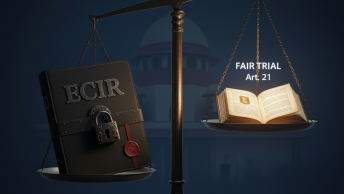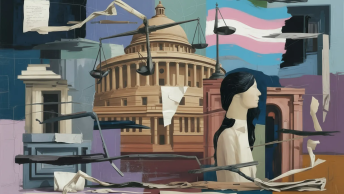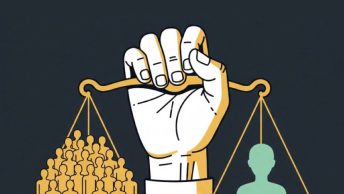[As part of our New Scholarship section, we have been inviting discussants to respond to the public law-themed articles featured in Volume 5 the Indian Law Review. You can access all the posts in this discussion here. In this post, our analysts, Mrityunjoy Roy and Saumya Khandelwal introduce the arguments made Prof. Farzana Akter in her paper titled, The Standard of Assistance from Legal Aid Lawyers: An Indian Perspective. The article can be accessed here.]
Summary
Access to justice has various barriers, more so for the poor – this is where legal aid is crucial since it plays a pivot role in ensuring equality before the law, the right to counsel and the right to a fair trial. In this article, Prof. Farzana Akter examines the standard of assistance provided by Indian legal aid lawyers in light of the international human rights normative framework. She demonstrates that the Indian legal aid system seeks to establish a functional framework to secure justice for all. However, it is not able to ensure that legal aid providers render effective assistance to the beneficiaries. As a result, the system complies with the international human rights standards in terms of legal provisions only; the quality of service delivered does not meet those standards. The article, therefore, recommends some measures to remedy the shortcomings of the Indian legal aid system to bring it into conformity with the international human rights standards and, eventually to guarantee effective assistance from legal aid lawyers.
Effective Assistance from Legal Aid Lawyers under the International Human Rights Normative Framework
Prof. Akter lists the existing human rights instruments like various United Nations documents involving the ICCPR and other soft laws like the General Assembly resolutions and other normative frameworks to explain the right to effective legal assistance from legal aid lawyers. She tries to explain how soft laws even though not binding play a crucial role by normative standards for States and foster the process of law development. Particularly, she mentions Basic Principles on the Role of Lawyers (“Principles”), the UN Principles and Guidelines on Access to Legal Aid in Criminal Justice Systems (“Principles and Guidelines”), United Nations Office on Drugs and Crime (“UNODC”) Model Law on Legal Aid in Criminal Justice Systems. She states succinctly the key points of these resolutions and principles.
The paper then looks at ICCPR and how it provides a person seeking legal assistance the right of choosing his/her own lawyer. She also mentions HRC decisions and a Model Law’s provision which further this right by enabling a legal aid beneficiary to make a request to change or appoint a new legal aid provider due to incompetence or negligence on the assigned lawyer’s part. She then discusses some HRC decisions that help understand this framework in a holistic manner, finally acknowledging that international human rights instruments consider confidential communication and effective representation by legal aid lawyers as essential components of a comprehensive legal aid system.
By observing the various soft law principles and HRC decisions, she states that States are obliged to ensure that appointed lawyers are not prevented from their professional functions due to any kind of intimidation, hindrance, harassment or improper interference, and thus become able to deliver their service independently. She further notes that Principles and Guidelines, the Model Law incorporates identical and elaborate provisions to develop programmes for tracking, monitoring and reviewing the service provided by legal aid providers. By these above discussions she wants to indicate that the current development of the human rights standards and jurisprudence in line with the ICCPR and other soft law principles extend the scope of States’ liability from mere appointment of legal aid lawyers to the concept of effective legal assistance.
Provisions concerning Legal Aid Lawyers under the Indian Legal Aid System
She begins this section with bringing forth India’s approach towards the service as not being straightforward as it failed to indicate whether the service would be provided as a charity, as a tool to resolve disputes within the framework of rule of law or as a means to bring social reform. She then goes on to mention post-independence cases such as Tara Singh v. State of Punjab in which the Indian judiciary took a restrictive approach to legal aid service, viewing it not as a fundamental right but a privilege extended to poor litigants.
Prof. Akter also lists out the various post-independence era reports like 14th Law Commission Report of 1985, Evaluation of Legal Aid and Legal Literacy – Tools of Social Justice and Expert Committee Report’ (1975) by Justice Iyer. She then explains how Article 39A places an obligation on the government’s shoulder to promote justice on the basis of equal opportunity for all, in addition to Articles 14 and 22(1) of the Constitution. She highlights some key Supreme Court decisions like Hussainara Khatoonand Khatri v. State of Bihar which emphasise this state obligation to provide legal aid in criminal proceedings.
She highlights how such developments led to the government constituting the committee to implement legal aid services (“CILAS”) to look into legal aid and informal settlement of disputes through forums such as Lok Adalat. The committee’s report thereafter led to the Legal Services Authorities Act (“LSAA”) in 1987.
Definitions of Legal Services under the Legal Services Authorities Act
In this section, she explains that the LSAA was framed keeping in mind the financial, social and procedural barriers that confront the ability of the poor and deprived sections of the community in approaching the legal system. It defines legal service as legal advice and representation and is allowed in all kinds of proceedings: civil, criminal or other related matters, before any forum or court. It envisages advocates’ fees, payment of court fees for filing cases before a court, expenses for preparing petitions, meeting costs incidental to litigation etc. The LSAA also organises Lok Adalats to deliver justice based on principle of equality before the law.
Certain classes of people like SC/ST persons, PwD, children, victims of human trafficking etc. are automatically eligible for legal aid, while others must undergo a financial eligibility test. It requires that such persons also have a prima facie case to prosecute, and violation of a right before providing legal aid. The Act establishes a system at all level of administration, with the NALSA being the apex body to coordinate legal aid.
Selection of Lawyers on Legal Aid Scheme:
In this section she elaborates on how lawyers are appointed for the legal services authorities through an empanelment system similar to how they are appointed in the UK, USA, Bangladesh and other common law systems. At the same time, discretion is provided to the authorities to engage senior lawyers or retainer lawyers for special cases on an ad hoc basis. NALSA has implemented the Legal Aid Defence Counsel system in 17 districts of the country in 2019. This system engages salaried lawyers who exclusively handle legal aid cases relating to criminal matters. It started as a pilot project and would last for two years.
She concludes that the Indian legal aid system is seemingly required to follow a fair and strong process for both the selection and monitoring of legal aid lawyers to ensure effective and meaningful assistance to the beneficiaries. The international human rights standards, as described earlier, call on States to maintain some criteria for the selection and appointment of legal aid lawyers. They also provide guidelines to ensure effective legal representation to legal aid recipients. Particularly, the Principles and Guidelines have provided elaborate provisions to guarantee effective legal assistance, which the Model Law builds on. The above illustrations indicate that the Indian system seeks to comply with the infrastructural requirements of the international standards of a functional legal aid system.
Current Standard of Assistance from Indian Legal Aid Lawyers
Referring to the UNDP reports and The Commonwealth Human Rights Initiative (“CHRI”) reports, Prof. Akter concludes that while the legal aid in India has achieved many policy triumphs, it fails to be realised on ground. She cites data to show that the majority of poor litigants don’t trust legal aid lawyers, and engage private lawyers at great expense.
She shows how majority of districts have appointed legal aid counsel, many haven’t appointed a single panel lawyer. She also casts doubt on the selection criteria for legal aid lawyers in India, in that the selection over emphasises years of practice over competence. The process is also too generalised, and does not focus on the specialisation of the lawyers during recruitment or assignment. Due to this, the system is not able to match proper lawyers as per the need of the recipient. There is also arbitrary allocation of cases which draws an adverse reaction from assigned lawyers, who then do not prioritise such work. Furthermore, there is no monitoring system to ensure that the lawyers actually help, and while litigants are allowed to change their lawyers if they don’t like them, due to their helplessness such choice is practically limited.
The article also discusses the issue of lack of commitment by legal aid lawyers. There is little interaction between lawyers and clients, and lawyers often don’t act diligently in the best interests of their clients. It argues that most lawyers join legal aid out of vested interests, rather than a sense of charity to the poor which in turn affects their commitment and quality of work. Further, the lawyers are generally young inexperienced lawyers for whom the legal aid is a source of sustenance, and the system is unable to attract senior, experienced lawyers. As a result of all this, the quality of legal aid remains poor.
However, Prof. Akter supplements this by saying that this is not solely the lawyer’s fault. She explains how lawyers in legal aid receive little to no training or assistance, and the remuneration provided by the legal aid authorities is too low and inconsistent. This affects the morale and interest of lawyers which in turn causes other problems that overall affect the quality of service provided. Furthermore, there is little infrastructural support for lawyers such as meeting rooms or printing services for court filings. Therefore, they have to depend on court complex infrastructure for this help which affects the low interaction between clients and lawyers.
A lack of a proper monitoring to monitor services of lawyers and progress of cases also results in perpetuation of poor legal aid. Almost half the district legal services authorities don’t have a monitoring committee, and lawyers in less than 1% of cases file progress reports for the same. This is partly the result of lack of infrastructure and funding to provide for a monitoring system, such that only 25% of district legal services authorities maintain registers for their cases. All of this together ensures perpetuation of poor legal aid, and lack of accountability and transparency in the system.
Despite all of the problems, Prof. Akter says there are still certain positive examples of legal aid in India and exemplary service by lawyers and authorities. For instance, Authorities of Andhra Pradesh, Haryana and some districts in Rajasthan preserve elaborate monitoring committee registers and reports that are useful in tracking the progress of legal aid cases. Furthermore, District Legal Services Authorities in Delhi, Andhra Pradesh and Madhya Pradesh operate the complaint mechanism to assess the quality of representation and take action, if necessary, against the appointed lawyer. The functioning of this mechanism sets a precedent for other Legal Services Authorities.
Conclusion
The article concludes that while the legal aid system in India has policies in place and envisions legal aid provision in line with global standards, it fails to realise these objectives in practice. It is clear that the system is not able to ensure effective assistance from legal aid providers to those seeking justice. Prof. Akter sees this to be the result of lack of commitment on part of the government, and non-provision of financial or infrastructural support by them to the system. She also cites the general lack of intent upon of lawyers, and lack of an effective monitoring system to further exacerbate the problem.
The ICCPR places an obligation to provide legal aid upon India which is clearly not being fulfilled. The Article recommends many changes to improve the legal aid system. It recommends that the process for recruitment of legal aid lawyers should be changed to focus on competence and interest rather than simply years of practice. There must also be training and sensitisation sessions for lawyers to motivate them for their work and the pay-scale of such lawyers should be rationalised in conformity with market rates to incentivise good performance on their part. The government is also implored to commit adequate resources to legal aid authorities to allow them to provide all the services and monitor the same, while giving lawyers adequate infrastructure to perform their work. Finally, it asks the government to learn from exemplary legal aid authorities around the world, and in India and to inculcate their learnings and best practices into the Indian system.
Dr. Farzana Akter is a Professor at University of Dhaka. Dr. Farzana Akter completed her PhD under a joint PhD programme from the Vrije Universiteit Brussel (VUB) and Universiteit Gent, Belgium.







